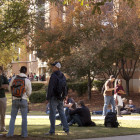
Millions of Under-educated, Under-employed Youth Costing Taxpayers, Study Finds
|
A growing segment of today’s youth are undereducated, underemployed and failing to build a solid economic foundation for their future, according to a study by the U.S. Department of Labor. These so-called opportunity youth are more likely to require government services, report worse health status and are more likely to be involved in criminal activity, the study found. Within the 16-24 age group, the study found at least 6.7 million (17 percent) could be classified as opportunity youth. Many have dropped out of high school or college and have been unable to find work. According to the report, opportunity youth represent a significant burden to taxpayers.








